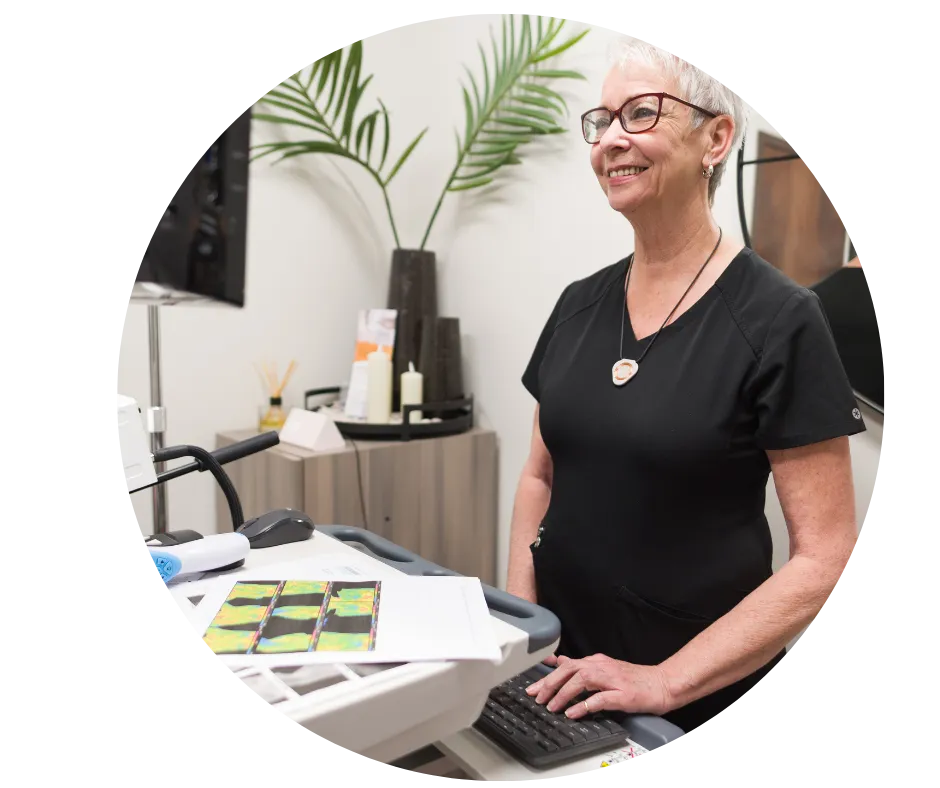Breast Thermography
Breast thermography is a diagnostic procedure that takes temperature-sensitive images the breasts to aid in the early detection of concerning breast tissue changes.
What Is
Breast Thermography?
Breast thermography is a diagnostic procedure that images the breasts to aid in the early detection of breast cancer.
It is based on the principle that chemical and blood vessel activity in both pre-cancerous tissue and the area surrounding developing breast cancer is almost always higher than in the normal breast.
Since pre-cancerous and cancerous masses are highly metabolic tissues, they need an abundant supply of nutrients to maintain their growth and this can increase the surface temperatures of the breast.

Breast thermography has an average sensitivity and specificity of 90%.
When used as part of a multimodal approach (clinical examination + mammography + thermography) 95% of early-stage cancers can be detected.
However, thermography does not have the ability to pinpoint the location of a tumor.
Consequently, breast thermography’s role is in addition to an ultrasound and physical examination, not in lieu of.
Thermography vs Mammography
Thermography
Thermography uses infrared (heat) sensors to detect heat and increased vascularity (angiogenesis) as the byproduct of biochemical reactions.
No radiation, non-invasive, harmless
Can be used as often as indicated to trace a problem, observe the effects of treatment, or monitor the health of the breast over time
Detects physiological changes using functional imaging
Non-contact, nothing and no one touches the breast tissue
Detects quickly changing breast tissue earlier than any other method
Findings will not diagnose cancer, but rather signal when further evaluation is required
Detects a pathologic (disease) state in the breast up to 10 years before a tumor is typically found by any other method of detection
Has the ability to detect fast growing and aggressive tumors due to the nature of the thermal imaging
A positive image represents the highest known risk factor for the existence of future breast cancer (10x more significant than family history)
Hormone use (like BHRT) has no effect on test outcomes
Average of 90% Sensitivity (only 10% of cancers missed) in all age groups. Of these 10%, the majority are slowly growing or poorly invasive
Average of 90% Specificity (only 10% false-positives), minimizing the need for unnecessary procedures
Mammography
Mammography uses x-rays (radiation exposure) through the breast to produce a structural image. Areas of suspicion would need to be dense enough to be visualized
Radiation is used for testing
Frequency should be limited due to radiation exposure and pain / compression of breast tissue concerns
Detects density changes with the use of x-ray imaging
Contact testing and compression of breast tissue required
Contact testing and compression of breast tissue required
Findings will not diagnose cancer, but rather signal when further evaluation is required
Detects a pathological (disease) state in the breast typically after a tumor is found with routine breast exams or symptomatology
Cannot detect exponentially fast growing tumors in the pre-invasive stage due to the nature of the x-ray imaging
Of those women with a positive image, only 9%, will actually have the disease (significant number of false positives)
Hormone use decreases sensitivity.
Average of 80% Sensitivity (20% of cancers missed) in women over age 50, and 60% Sensitivity in women under the age of 60.
Average 75% Specificity (25% false-positives). 85% of all mammography-initiated biopsies are negative.
What can I expect during a thermal imaging appointment?
The thermography technician (RN or trained technician) who performs the thermogram will explain the procedure.
For this procedure, an ultra-sensitive infrared (heat-sensitive) camera and specialized computer program is used to detect, analyze, and produce high-resolution diagnostic images of temperature and vascular changes in the breast tissue.
Photos are taken of the unclothed breasts from multiple angles using the infrared camera, and only a thermographic image is saved and then sent to a radiologist for review and formalized report.
The whole procedure only takes a few minutes and is completely painless and without any compression of the breasts or exposure to radiation.

Ready to schedule
Breast Thermography
to evaluate your breast health?


Well Infused Franchise, LLC
30 N Gould St Ste R
Sheridan, WY 82801
2024 © Well Infused LLC | All Rights Reserved | Well Infused trademarks and brands are the property of their respective owners














